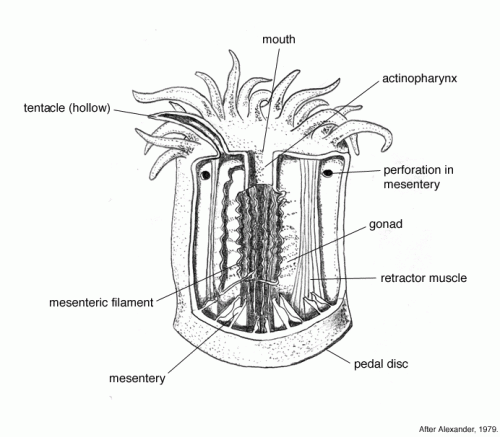Anthozoas
Anthozoa is a class within the phylum Cnidaria that contains the sea anemones and corals. Unlike other cnidarians, anthozoans do not have a medusa stage in their development. Instead, they release sperm and eggs that form a planula, which attaches to some substrate on which the cnidarian grows. Some anthozoans can also reproduce asexually through budding. Like those of other cnidarians, the individual polyps have a cylindrical body crowned by a ring of tentacles surrounding the mouth. The mouth leads into a tubular pharynx which descends for some distance into the body before opening into the gastrovascular cavity that fills the interior of the body and tentacles. Unlike other cnidarians, however, the cavity is subdivided by a number of radiating partitions, or mesenteries. The gonads are also located within the cavity walls. All cnidarian species can feed by catching prey with nematocysts; sea anemones are capable of catching fish and corals of catching plankton. Some of the species also harbour a type of algae, dinoflagellates called zooxanthellae, in a symbiotic relationship; the reef building corals known as hermatypic corals rely on this symbiotic relationship particularly. The zooxanthellae benefit by using nitrogenous waste and carbon dioxide produced by the host or , and the cnidarian gains photosynthetic capability and increased calcium carbonate production in hermatypic corals.
Anemones and certain species of coral live in isolation, however most corals form colonies of genetically identical polyps; these polyps closely resemble anemonies in structure, although are generally considerably smaller. Most kinds of stony coral live in all parts of the underwater world.
Source: http://en.wikipedia.org/wiki/Anthozoa
| ||||||||||||||||||||||||||||||||||||||||||||||||||||||||||||||||||||||||||||||||||||||||||||||||||||||
Virtual museum of the Czech Geological Survey, www.geology.cz, (C) Czech Geological Survey, 2011, v.0.99 [13.12.2011]


![[ENG]](img/vlajka-cr.gif) Česky
Česky 


